
How to Provide Safe Chew Toys for Dogs
ebook include PDF & Audio bundle (Micro Guide)
$12.99$11.99
Limited Time Offer! Order within the next:

Providing your dog with safe chew toys is an essential part of responsible pet ownership. Dogs have a natural instinct to chew, and without the proper outlets for this behavior, they can turn to destructive chewing of furniture, shoes, or even electrical cords. Offering safe and suitable chew toys not only satisfies their instinctual needs but also provides physical and mental stimulation, helping to reduce stress and anxiety.
However, not all chew toys are created equal. Some can be harmful to your dog, either through choking hazards, ingestion of harmful materials, or causing unnecessary wear and tear on their teeth. In this article, we'll explore how to select, provide, and monitor chew toys for dogs in a way that promotes safety and health.
Understanding the Importance of Chewing for Dogs
Chewing is a natural behavior for dogs, both in the wild and in domesticated environments. For wild dogs and their ancestors, chewing served several practical purposes:
- Teething: Puppies chew to soothe the pain caused by teething.
- Hunting and Eating: Chewing on bones, hides, or other items helps wild dogs break down food and clean their teeth.
- Stress Relief: Chewing can serve as a method to reduce anxiety and relieve boredom, which is why many dogs will chew when left alone or during stressful situations.
For domesticated dogs, chewing is no less important. It helps them maintain strong jaws and teeth, and it can alleviate boredom or anxiety, especially if they are confined or left alone for extended periods. Providing proper chew toys that are safe and beneficial to their well-being should therefore be part of every dog owner's routine.
Common Risks of Unsafe Chew Toys
Unfortunately, not all chew toys are safe for dogs. Some toys can pose significant risks that lead to severe health problems. Here are some common issues with unsafe chew toys:
1. Choking Hazards
Some chew toys are small or can break into smaller parts, which increases the risk of choking. Dogs can accidentally swallow pieces of a toy that become dislodged, blocking their airway and leading to suffocation.
2. Toxic Materials
Certain chew toys may contain harmful chemicals, such as BPA, phthalates, or lead, that can be toxic to dogs. Ingesting these substances can lead to a variety of health problems, including gastrointestinal distress, organ damage, or even long-term health issues.
3. Dental Damage
Chew toys that are too hard can cause dental damage to dogs. Hard plastic or bone-like materials can crack or break a dog's teeth, leading to painful dental issues or expensive treatments. Dogs with weaker teeth, such as older dogs or puppies with developing teeth, are particularly susceptible.
4. Gastrointestinal Problems
When dogs chew on toys that break into small, ingestible pieces, there's a risk of those pieces being swallowed. These small pieces can lead to gastrointestinal blockages, which are potentially life-threatening and require surgical intervention.
5. Behavioral Issues
If chew toys are not appropriately designed or engaging, they might not fulfill the dog's natural chewing instincts, leading to frustration and unwanted behaviors. In some cases, dogs may turn to more destructive behaviors, like chewing on furniture or shoes, if their chew toys fail to capture their interest.
Selecting the Right Chew Toy
When selecting a chew toy for your dog, there are several important factors to consider. These factors will help ensure the toy is safe, durable, and appropriate for your dog's size, age, and chewing habits.
1. Size and Strength of the Dog
Choosing the right size toy for your dog is crucial. A toy that is too small can pose a choking hazard, while one that is too large may be difficult for your dog to manipulate or enjoy.
- Small Dogs: Small chew toys designed for small breeds are ideal for tiny dogs like Chihuahuas or Dachshunds. These toys are generally softer and smaller in size, preventing the risk of choking.
- Medium to Large Dogs: For larger dogs, the toy needs to be much sturdier. Breeds like German Shepherds or Golden Retrievers may require a tougher material that won't easily break or tear.
- Power Chewers: If your dog is an aggressive chewer (such as some breeds like Pit Bulls or Labrador Retrievers), you'll need a toy made from tougher materials like rubber or nylon. These materials are designed to withstand intense chewing pressure.
2. Material Safety
The materials used in a chew toy can make a significant difference in its safety. The following materials are generally considered safe for dogs:
- Rubber: High-quality, durable rubber is ideal for most dogs. It is flexible, non-toxic, and able to stand up to intense chewing. Rubber toys are often designed to have a bounce or erratic movement, making them more engaging.
- Nylon: Nylon chew toys can be tough and long-lasting. Some nylon toys are infused with flavors to make them more attractive to dogs.
- Natural Wood: Some chew toys are made from natural wood, such as bamboo or specific types of untreated wood. These can be good for dogs who like to gnaw on branches and sticks.
On the other hand, avoid toys made from low-quality plastic, vinyl, or any material that contains harmful chemicals, such as BPA or phthalates. Also, steer clear of toys that contain small, detachable parts that could easily be swallowed or choked on.
3. Durability
Chew toys come in various levels of durability. While puppies and older dogs may require softer toys, dogs with strong jaws may need extra-durable toys that can withstand heavy chewing. Always select a toy that matches the chewing behavior of your dog.
4. Texture and Shape
The texture and shape of the chew toy are equally important. Some dogs enjoy toys with ridges, bumps, or grooves, as these features provide a satisfying chewing experience. Additionally, the shape of the toy can influence how much it captures your dog's attention. A toy with an irregular shape may have more unpredictability, which could keep your dog engaged for a longer period.
5. Interactive Features
Many chew toys come with interactive features, such as treat compartments, squeakers, or puzzle elements. These features can help keep your dog mentally stimulated and engaged, which is especially important if your dog is left alone for long periods of time.
Types of Safe Chew Toys
There are several different types of chew toys available, and each type has its own benefits depending on your dog's needs. Below are the most common types of safe chew toys:
1. Rubber Chew Toys
Rubber toys, like the classic Kong, are a fantastic choice for dogs of all sizes. They are durable, safe, and often have a soft, pliable texture that won't damage your dog's teeth. Some rubber toys are hollow inside and can be filled with treats, which can help stimulate your dog mentally and physically.
2. Nylon Chew Toys
Nylon chew toys are another excellent option for tough chewers. They are hard, durable, and can withstand a lot of chewing. Some nylon toys are flavored, which adds an extra level of attraction. However, be cautious with nylon toys, as they may be too hard for puppies or older dogs with sensitive teeth.
3. Natural Bone Chews
Natural bone chews can provide dogs with a satisfying chewing experience. Be sure to select bones that are size-appropriate for your dog and that are non-toxic. Avoid cooked bones, as they can splinter and cause injury to your dog's digestive tract. Opt for raw bones or specially processed bones designed for dogs.
4. Edible Chews
Edible chews, such as rawhide, bully sticks, or dental chews, can be great options for your dog. They are not only tasty but can also help clean your dog's teeth and satisfy their need to chew. However, always supervise your dog when they are chewing on edible chews to prevent them from swallowing large chunks, which could cause choking or intestinal blockages.
5. Interactive Puzzle Toys
Interactive puzzle toys can be a great way to engage your dog mentally and physically. Many of these toys can be filled with treats, and they require your dog to solve a puzzle or work through a challenge to access the treats inside. These toys are ideal for dogs who get bored easily and need extra stimulation.
Monitoring Your Dog's Chewing Habits
Even when providing safe and appropriate chew toys, it is crucial to monitor your dog's chewing behavior regularly. Here are some tips for ensuring your dog's safety while chewing:
1. Supervision
Always supervise your dog, especially when introducing a new chew toy. This ensures that they do not swallow pieces that could cause harm, and it allows you to check the toy's durability to make sure it doesn't break into smaller, hazardous parts.
2. Regular Inspection
Inspect chew toys frequently for signs of wear and tear. If a toy begins to break apart, it's time to replace it. Damaged toys can become dangerous if your dog starts to swallow fragments or small pieces.
3. Limit Access to Too Many Toys
While it's tempting to provide your dog with a vast array of chew toys, limiting the number of toys available at a time helps to keep the experience more engaging. Rotate toys to prevent boredom and ensure your dog is always interested in their playtime.
Conclusion
Chew toys are an essential part of a dog's well-being, providing both physical and mental stimulation while helping to satisfy their natural instincts. By carefully selecting safe, durable toys that match your dog's size, age, and chewing habits, you can ensure that your dog enjoys a positive and safe chewing experience. Always remember to supervise your dog, inspect toys regularly, and provide a variety of chew options to keep your dog happy, healthy, and entertained.

How to Incorporate Vintage Decorations into Your Holiday Home Decor
Read More
How to Organize Your Bathroom with Minimalistic Storage Solutions
Read More
How to Renovate Your Home to Improve Indoor Air Quality
Read More
How to Sort and Store Holiday Cards and Decorations
Read More
Turning Your Deep Learning Expertise into Passive Income
Read More
How To Use Online Courses to Boost Your Skills
Read MoreOther Products

How to Incorporate Vintage Decorations into Your Holiday Home Decor
Read More
How to Organize Your Bathroom with Minimalistic Storage Solutions
Read More
How to Renovate Your Home to Improve Indoor Air Quality
Read More
How to Sort and Store Holiday Cards and Decorations
Read More
Turning Your Deep Learning Expertise into Passive Income
Read More